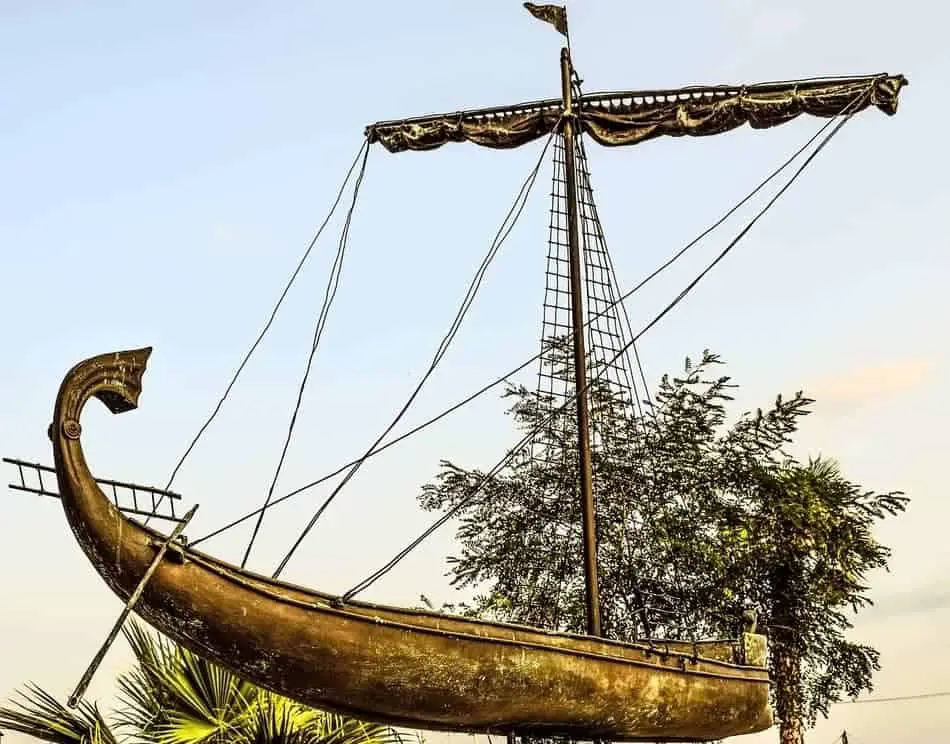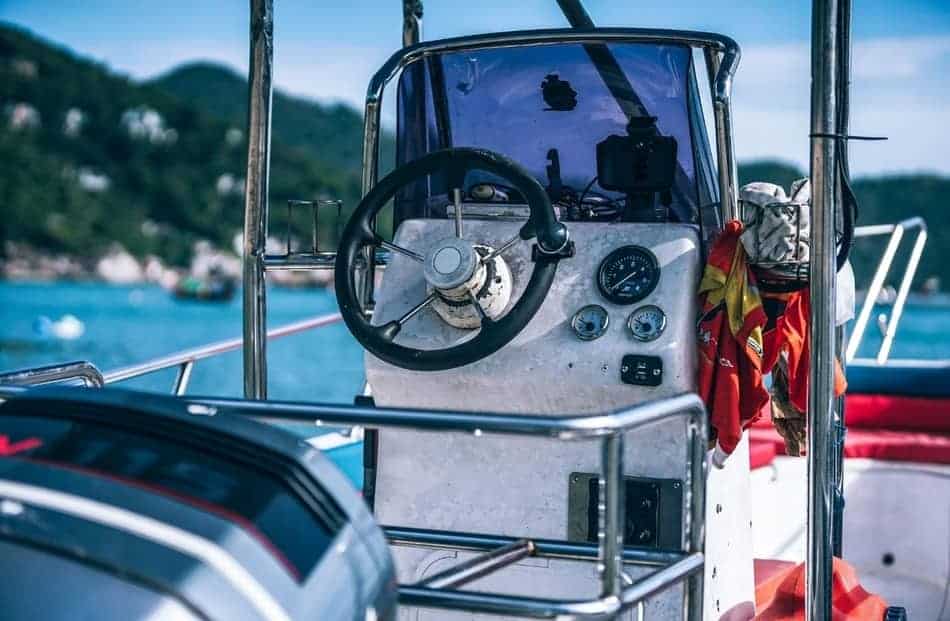Most boats around the world have steering wheels on their right side. Here’s why boats have steering wheels on the right side (starboard side) of the boat rather than on the left side or middle.
The boat steering wheels are often on their right side because boats are driven using oars in the past, and since many people are right-handed, the oar is fixed on the boat’s right side at the rear end, which stayed like that because being traditional in the waters (sea) is well accepted.
So, the steering wheels on the right (starboard) side of the boat are due to that; otherwise, if many people back then were left-handed, then oars would be placed on the left side, and most boats today would be having steering wheels on the left side of the boat.
See the position of the oar on an ancient boat in the image below. The oar is placed on the right (starboard) side of the boat at the boat’s stern (rear). That oar position on the boat gave origin to many terms (port and starboard) and rules (port-to-port passing rules and many).
Also, many people say that “the boat’s steering wheel on the right side gives better visibility from the bow to the stern.” Even that saying is not an appropriate reason. Later in the post, we will see how those new terms and rules developed due to the boat’s oar position.
Apart from the tradition, there used to be a technical reason (10 or 15 years back) why the steering wheel’s position on the boat’s right side. The propeller’s torque will sink the port side a little (less than 5 degrees), so more weight (cockpit) is added to the boat’s right side to compensate for that.
However, the torques-related issue is solved long back with the addition of trim tabs. So, it’s not a worry these days, which means there is no technical-related issue (reason) behind why the steering wheel is on the boat’s right side.
So, if anyone says the reason behind the steering wheel on the boat’s right side is because of that technical reason or it’s for better visibility, those reasons are not valid. Check the “The real reason (originates from ancient times)” section below to know why they aren’t valid reasons.
The real reason (originates from ancient times)

If you have read the above section, you may already know the “main” reason why the steering wheels are on the boat’s right side (and you can skip the below section if you don’t want the detailed answer for that). But, there is always more to that; we will see that now.
Boats are driven by oars long back. Since most people are right-handed, the oar is kept on the right side of the boat near the stern (rear) end. From then, the same tradition (rule) is being followed; that’s why even now, the steering wheels are often on the right side of the boat.
Since the steering board (an oar) is on the boat’s right side, many things have changed and created so many new rules (like the port-to-port passing rule) and terms (starboard indicating the boat’s right side and port indicating the boat’s left side).
Since many people got used to the port-to-port passing rule, and no one wants to change the practices again by keeping the steering wheel on the left side. However, some boats have the steering wheel on the left side, and some have it in the center these days. But, most of them are on the right side.
Port-to-port passing rule: Boats approaching each other head-on should give way on the port side, meaning the boat has to turn towards the right side while passing the approaching boat head-on.
The port-to-port passing rule and the “port and starboard” names came due to the steering board’s (oar) position on the boat in the past. We will now see them in a detailed way.
Why do boats use the port-to-port passing rule?
Here’s why boats use the port-to-port passing rule while two boats are approaching head-on.
The boats use the port-to-port passing rule because in the past, the boat’s oars are on the right side, and it could damage or interface with other boat’s oars if they pass on the starboard-to-starboard side. So, passing on the port-to-port side will prevent that, and later it became a rule.
So, with the steering board (an oar) on the right side, if the two approaching boats passed (closely) on that (starboard) side, it could damage or interface with other boats’ steering board (an oar) or any gear, which could break the oar or oarlock and sometimes it could be dangerous as well.
To prevent the interfacing (touching) of the steering boards (oars) of the two approaching vessels, they need to be passed on the other side of the boat, which is the boat’s left side (port side). That’s why the “port-to-port” passing rule started, and even now, it’s being followed (even though many people don’t use oars).
If most people were left-handed back then and if they placed the oars on the left side (port side) of the boat in the past, the “port-to-port” passing would have changed to the “starboard-to-starboard” passing rule, and many other things would have changed along with it.
Since the port-to-port passing rule is already started, it gives the operator better visibility while passing the approaching vessel if the steering wheel is placed on the right side. The operator can clearly see the space on the right side to pass port to port without any contact or collision.
However, it wouldn’t make much of a difference these days by having a boat’s steering wheel on the left side (but it needs some time for you to adjust to operating from that side).
It won’t diminish or increase your visibility by changing the steering wheel’s position on the boat. So, better visibility is not the appropriate reason why boats have steering wheels on the right side.
Why do boats use port and starboard?
Why boats use the names “port” indicating the boat’s left side and the “starboard” indicating the boat’s right side? Why can’t it be just “left” and “right”? Here’s why the boats use the names port and starboard rather than left and right.
From your viewpoint (if the boat is coming towards you head-on), the boat’s left side would be starboard, and the right would be port. But in reality, the reverse is true. To avoid similar confusions, boats use the port (indicating left side) and starboard (indicating right) instead of left & right.
The terms “right” and “left” will vary from the perspective you are looking at, and it creates a lot of confusion for you and others. So, universalizing the terms is a better solution. We will now see why “starboard” and “port” are used in boats instead of any other names.
Why boat’s right side is called the starboard side?
Here’s why boats use starboard, indicating the boat’s right side rather than any other names.
The boat’s right side is called starboard because, long back, the steering board (aka oars) is placed on the right side of the boat, so people used to call that side (boat’s right side) as steering board side. Later, that “steering board” has changed to “steerboard” and then finally “starboard.”
After many alternations, the “steering board” has changed to“starboard” over time. If they placed the oars on the left side (port side) of the boat in the past, the “port and starboard” names would be reversed (the port for the right side, starboard for the left side).
Why boat’s left side is called the port side?
Here’s why boats use port, indicating the boat’s left side rather than any other names.
The boat’s left side is called the port because the boat is parked towards its left side at the port (wharves) since parking the boat towards its right could damage the oar due to its constant bumping with the pier. As the boat’s left side faces the port (wharves), the name “port” came from that.
But, initially, the “ladder board” is referred to as the port side in the past because people used to park the boat on the other (left) side, so it didn’t interfere with steering and used a ladder to get off. Later, that “ladder board” has changed to “larboard” and then finally “port.”
After many alternations, the “ladder board” has changed to“port” over time. If they placed the oars on the left side (port side) of the boat in the past, the “port and starboard” names would be reversed (the port for the right side, starboard for the left side).
Do all boats have steering wheels on the right side?

If you read the above section, then by now, you must have known why the boats have the steering wheel on the right side of the boat. But do all boats have steering wheels on the right side?
All boats don’t have steering wheels on the right side, some boats have steering wheels on the left side, and some boats (ships) have the steering wheel on the middle. However, most boats have steering wheels on the right side because most (90%) people are right-handed, so the majority wins.
Since the majority of the people were right-handed back then (and even now), most boats steering wheels are on the right side. If the majority of the people were left-handed back then, most boats steering wheels would be on the left side (then and even now).
Did you know? About 90 percent of people are right-handed, says Corballis. The remaining 10 percent are either left-handed or some degree of ambidextrous, though people with “true” ambidexterity—i.e., no dominant hand at all—only make up about 1 percent of the population.
American Psychology Association
So, the steering board (an oar) is installed at the boat’s right side at the stern (rear) end in the past. That continued like that, and many people got used to it since many people are right-handed, so that’s why most boats steering wheels are on the right side of the boat rather than on the left or middle.
Bottom line
Boats often have steering wheels on their right side because boats are driven by oars in the past, and many people are right-handed, so they fixed the oar on the boat’s right side at the rear end. That position continued like that, and that’s why we have the boat steering wheel on the right side (even now).
Since the oar is fixed on the boat’s right side, the port-to-port passing started because the oar could damage or interface with the approaching boat’s oar if they pass on the right side. Passing on the other side won’t interface with both the oars, which is the port side, so port-to-port passing.
Since the oar is on the right side and the oar is also known as the steering board, the starboard evolved from that steering board to the steerboard and then the starboard. Since boats are parked on their left side facing the port at the port (wharves), the port name came from that.
If most people were left-handed back then, then all the names and rules would have become reverse, and most boats would be having steering wheels on the left side. Due to the most right-handers in the past (and even now), the boat’s steering wheels are on the boat’s right side, which is the actual reason behind that steering wheel on the boat’s right side, nothing else.
